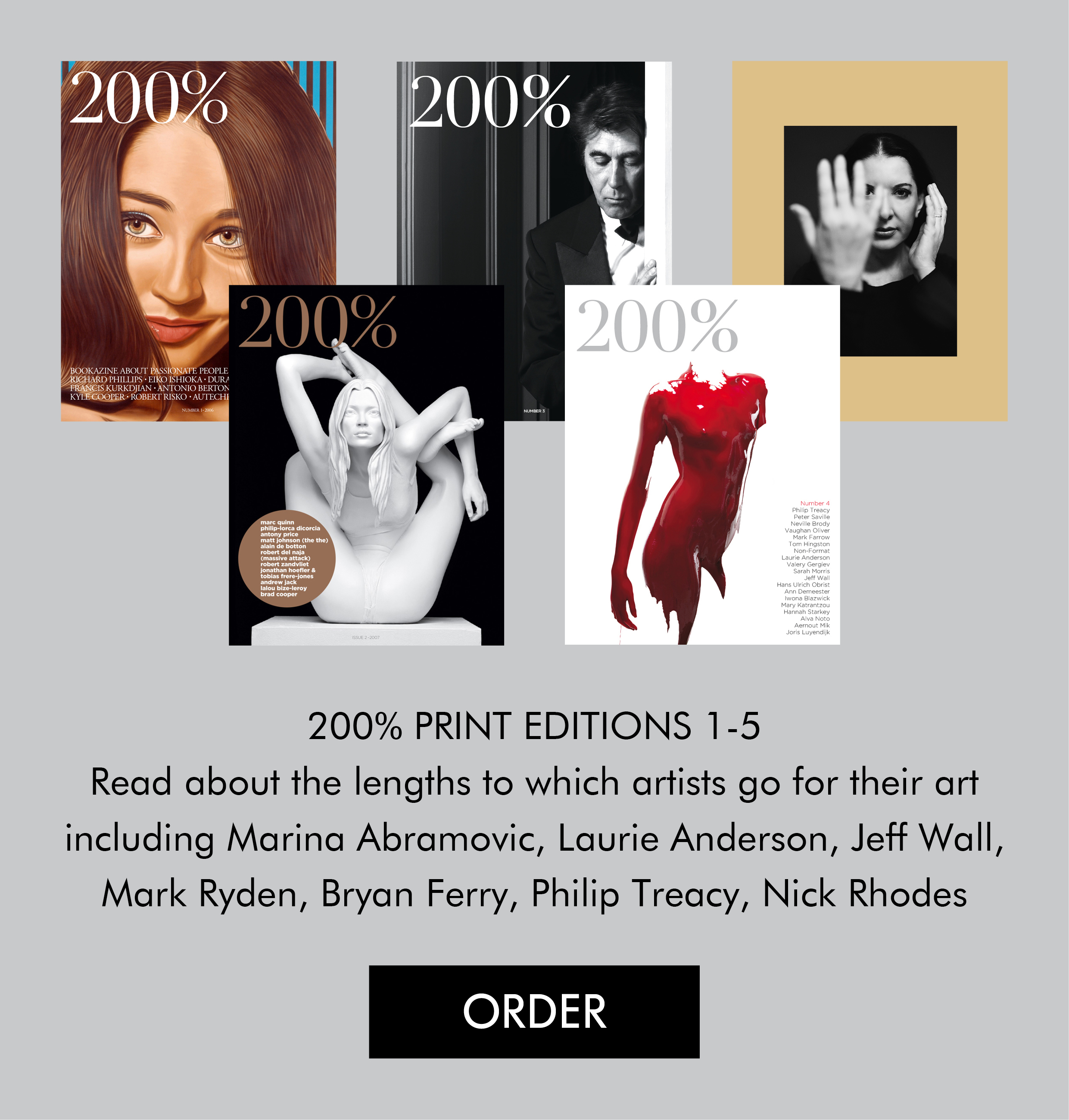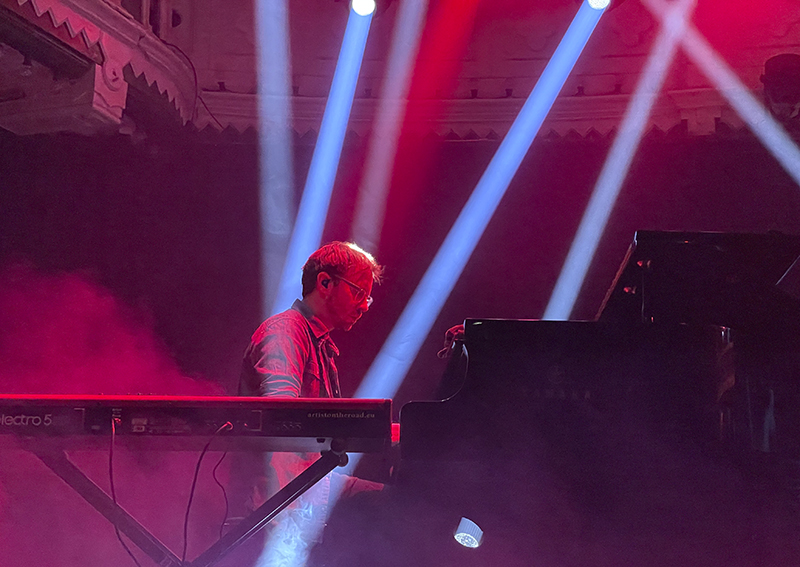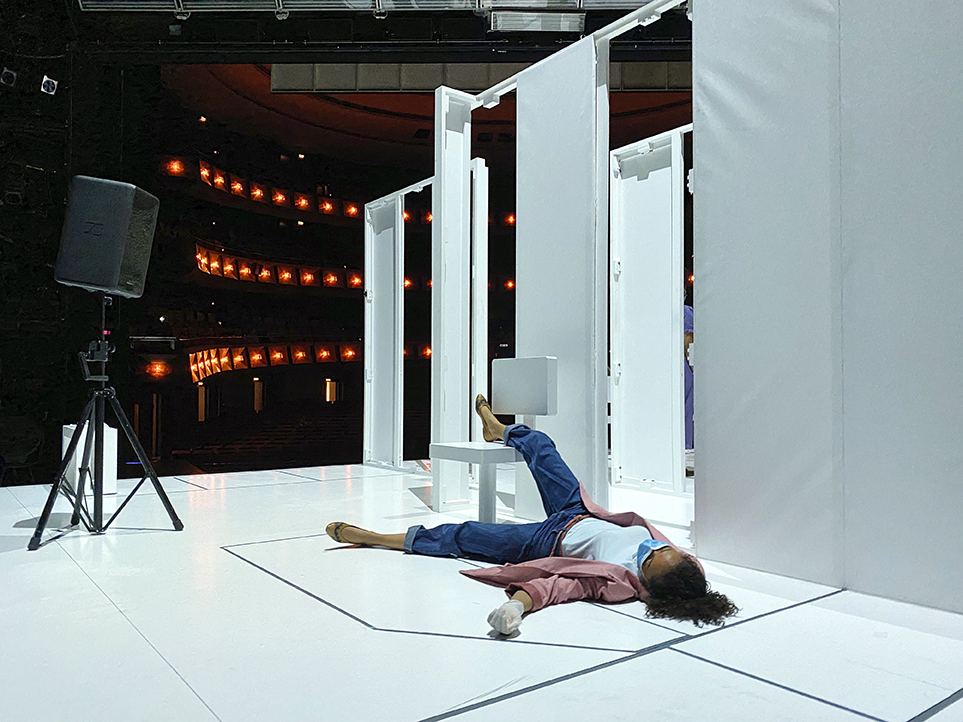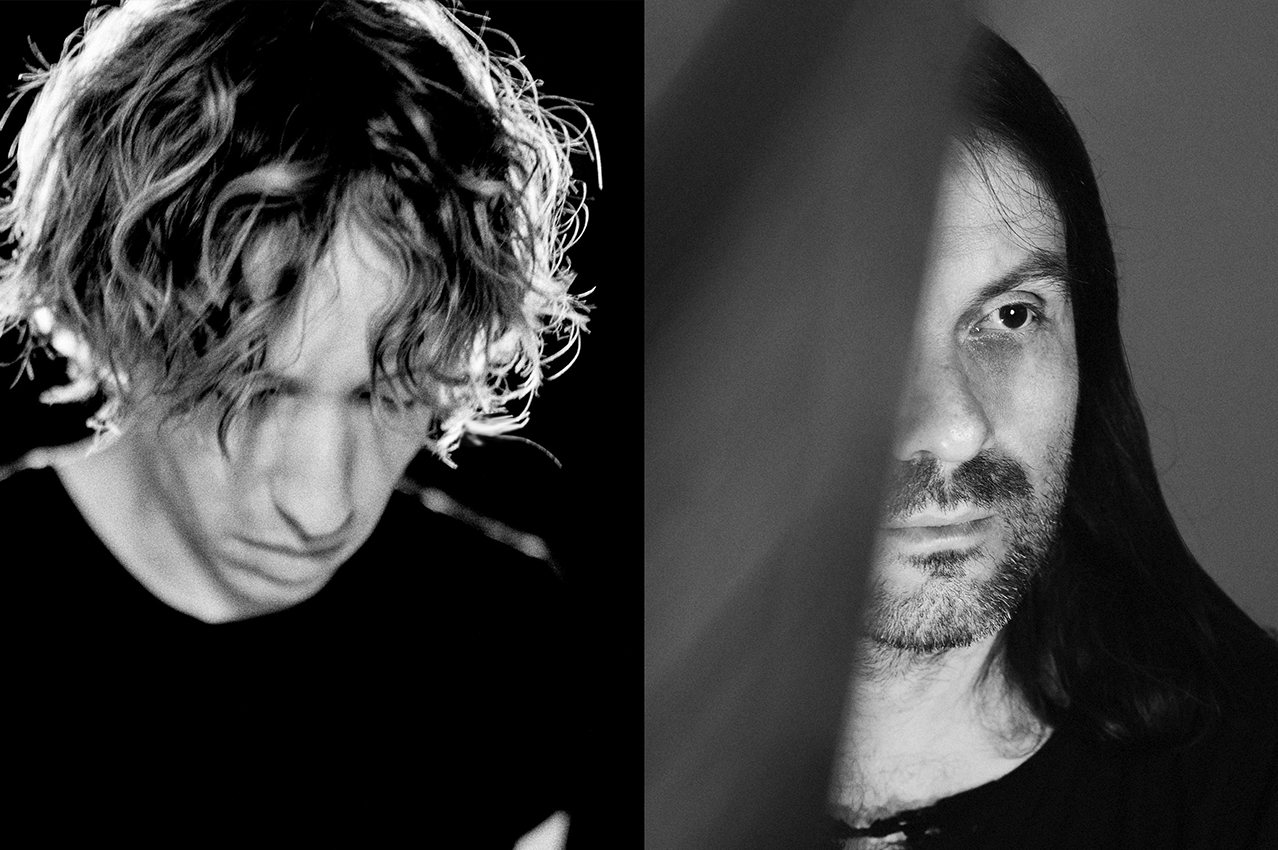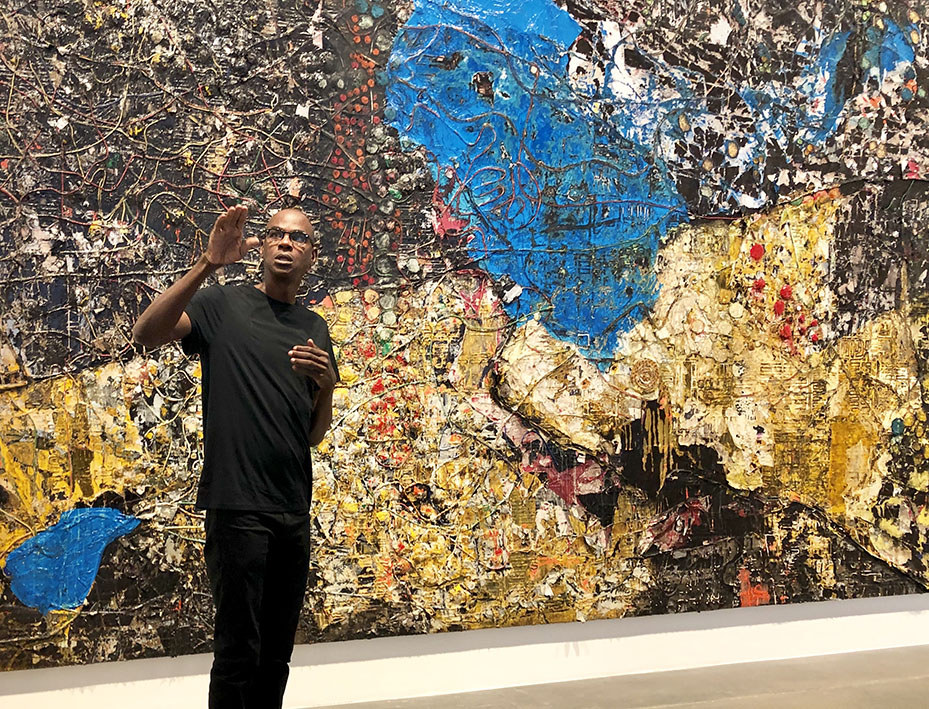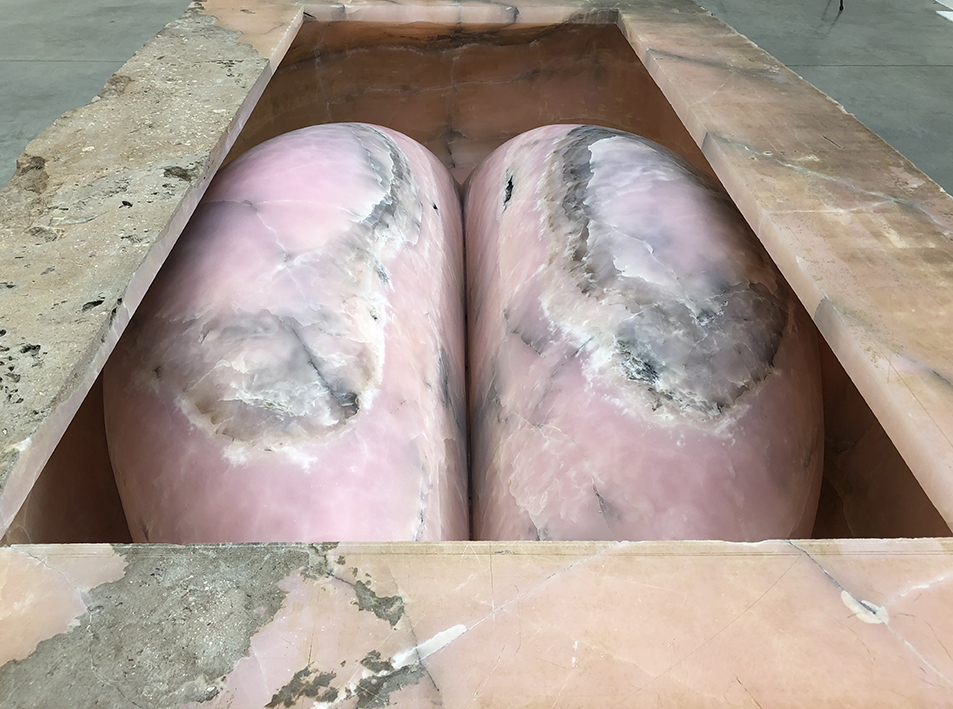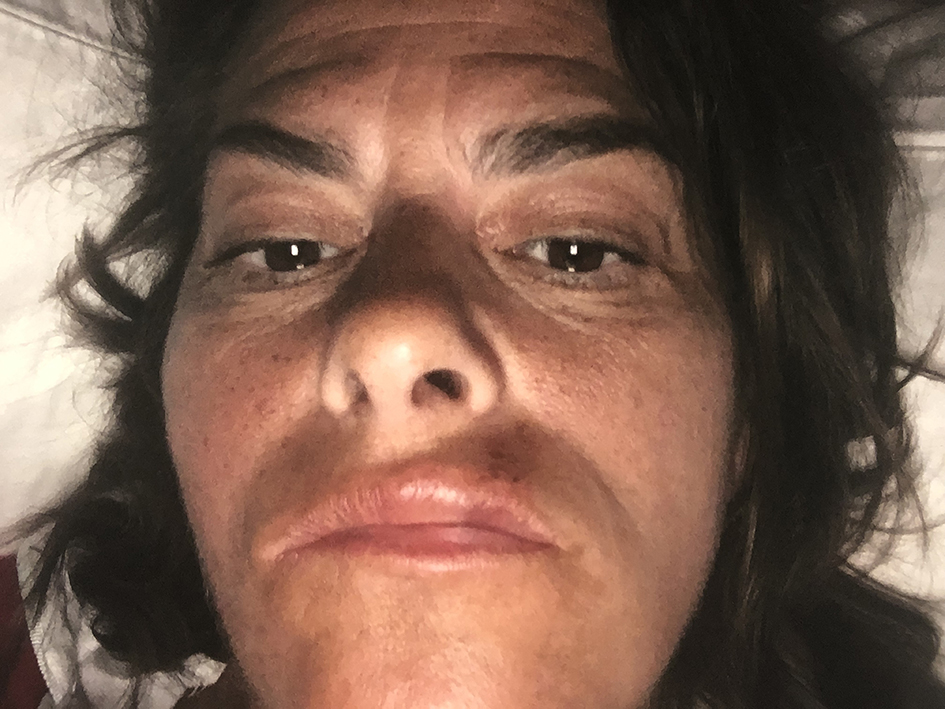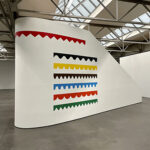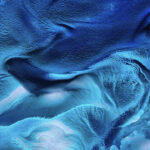 “As a member of the press we can offer you a reduction on the audio guide of our Lucian Freud exhibition”, the cashier of the National Portrait Gallery informed me when I collected my ticket at the box office. “No, thank you”, I smiled, “I have my own guide today.”
It was the ‘Man with a Blue Scarf’, Martin Gayford, the art critic and historian, who was going to give me a private tour of Freud’s portraits, including his own portrait by the German-born artist who died last year. On being a model for Freud, Gayford wrote a wonderful book about the 40 sittings he undertook for his portrait by Freud, called: ‘Man with a Blue Scarf’.
From the book we gain a lot of insight into Freud’s life and work as Gayford vividly describes what it is like to be his model, his creative process and what he was like as a person, whether in his studio or a social environment, as they, after the sittings, spent a lot of time together in Locanda Locatelli and The Wolseley – Freud’s favourite restaurants.
Without using too much technical terminology, Gayford explains the artistic concerns of portrait painting, such as how the interaction between the artist and sitter contributes to the painting, what the portrait painter is actually painting, and why it is of no interest to Freud whether a final portrait is an accurate copy of the model.
As Gayford obviously knew Freud and his work very well, I was interested to hear his opinion on Freud’s ‘Portraits’ exhibition at the National Portrait Gallery. Via email, I proposed to him that we visit the exhibition together and, whilst viewing the portraits of the artist, to discuss what Freud’s work does for him on a personal and emotional level. He accepted my invitation and we met on a rainy and windy day at the end of February.
The first thing I noticed about Gayford, when we met in the reception area of the Gallery in front of a collection of Freud’s etchings, was the red scarf hanging around his neck. That was a pity, as I was curious to see the item that has now been immortalized by Freud, the royal blue scarf, in real life. As to Gayford himself, there were no discernable differences between the painting and the man standing in front of me: the same pronounced angular eyebrows, a penetrating gaze, the congenial and welcoming appearance are all present in the flesh. The only difference was the colour of his hair that has become more grey as his portrait was produced more than eight years ago.
My assumption that he has seen the exhibition already is correct. “I believe it is actually the fourth time now”, he answers in a crystal cut accent. I ask him about his expectations for the exhibition. “I expected it to be very good given it was co-curated by David Dawson, Lucian’s assistant since 1991, who knew everything about him. Although Lucian did some great landscapes and still life paintings, I think cutting this exhibition down to just people gives it a sort of clarity. I think it is actually the best Lucian Freud exhibition I’ve seen to date”.
The exhibition features 130 portraits by Freud of work dating from 1940 until his last unfinished painting from 2011 of Dawson with his whippet Eli. I’m curious to know if Gayford discovered new things in Freud’s work. “Before I saw the exhibition I would have said that maybe the early mid 1990s, when he made these exuberant, large scale, powerful Leigh Bowery and Sue Tilley paintings, were his peak, but actually he carried on and managed to make his painting more profound. His later work is not as big, powerful and volumetric like the Bowery and Tilley paintings but it gets more subtle”.
We decide to see ‘The Man with a Blue Scarf’ first and he says to follow him. Similar to the David Hockney and Leonardo DaVinci shows, the exhibition space is very crowded with people. Gayford doesn’t seem to be intimidated by the volume of people and skilfully leads me through the masses.
En route, he stops in front of ‘Sleeping by a Lion Carpet’ (1996), a large painting of one of the famous portraits of the curvaceous Sue Tilley who posed numerous times for Freud. “It was November 1995, during the period that Freud was working on this painting, when we first met at his new studio in Holland Park”, Gayford recalls. “He opened the door with a brush and a palette in his hand, led me into his studio where I saw this ‘Big Sue’ portrait, which was near completion”.
The cause of their meeting was a result of an article written by Gayford for ‘Modern Painters’, which was published in September 1995. “The article was about Venetian Painting and, in particular, about Titian”, he explains. “In the article I mentioned Lucian as a contemporary artist who was a bit similar to Titian. It turned out that Titian was Lucian’s favourite artist. He sent me a postcard to let me know that he was pleased to see his name linked to Titian. We then made an appointment to have lunch together. That’s how our relationship started”.
As we continued our route, in the distance, in the opening of room number nine into room number ten, already my eye catches Gayford’s portrait as he looks straight at the viewer. “As there is a strong gaze in my portrait the curators decided to position it exactly here as a hinge to room number ten”, Gayford informs me. The gaze works like a magnet as it is powerful, determined and there is, indeed, what Freud describes in the book a certain “alertness” on Gayford’s face. There is also a serious look of a father warning his toddler not to do something, but not entirely succeeding as there is also a half-smile on his face.
The intensity of the royal blue scarf in the portrait produces a three-dimensional effect. I study it up close to see how the effect is created, remarking to Gayford that I would like to compare it with his scarf; as he is wearing a red one today that isn’t possible. He comments that he wears scarves in different colours as he likes scarves. The blue one he is wearing in the portrait, which is now linked with him for the rest of his life, was the one he happened to be wearing that day.
“As a member of the press we can offer you a reduction on the audio guide of our Lucian Freud exhibition”, the cashier of the National Portrait Gallery informed me when I collected my ticket at the box office. “No, thank you”, I smiled, “I have my own guide today.”
It was the ‘Man with a Blue Scarf’, Martin Gayford, the art critic and historian, who was going to give me a private tour of Freud’s portraits, including his own portrait by the German-born artist who died last year. On being a model for Freud, Gayford wrote a wonderful book about the 40 sittings he undertook for his portrait by Freud, called: ‘Man with a Blue Scarf’.
From the book we gain a lot of insight into Freud’s life and work as Gayford vividly describes what it is like to be his model, his creative process and what he was like as a person, whether in his studio or a social environment, as they, after the sittings, spent a lot of time together in Locanda Locatelli and The Wolseley – Freud’s favourite restaurants.
Without using too much technical terminology, Gayford explains the artistic concerns of portrait painting, such as how the interaction between the artist and sitter contributes to the painting, what the portrait painter is actually painting, and why it is of no interest to Freud whether a final portrait is an accurate copy of the model.
As Gayford obviously knew Freud and his work very well, I was interested to hear his opinion on Freud’s ‘Portraits’ exhibition at the National Portrait Gallery. Via email, I proposed to him that we visit the exhibition together and, whilst viewing the portraits of the artist, to discuss what Freud’s work does for him on a personal and emotional level. He accepted my invitation and we met on a rainy and windy day at the end of February.
The first thing I noticed about Gayford, when we met in the reception area of the Gallery in front of a collection of Freud’s etchings, was the red scarf hanging around his neck. That was a pity, as I was curious to see the item that has now been immortalized by Freud, the royal blue scarf, in real life. As to Gayford himself, there were no discernable differences between the painting and the man standing in front of me: the same pronounced angular eyebrows, a penetrating gaze, the congenial and welcoming appearance are all present in the flesh. The only difference was the colour of his hair that has become more grey as his portrait was produced more than eight years ago.
My assumption that he has seen the exhibition already is correct. “I believe it is actually the fourth time now”, he answers in a crystal cut accent. I ask him about his expectations for the exhibition. “I expected it to be very good given it was co-curated by David Dawson, Lucian’s assistant since 1991, who knew everything about him. Although Lucian did some great landscapes and still life paintings, I think cutting this exhibition down to just people gives it a sort of clarity. I think it is actually the best Lucian Freud exhibition I’ve seen to date”.
The exhibition features 130 portraits by Freud of work dating from 1940 until his last unfinished painting from 2011 of Dawson with his whippet Eli. I’m curious to know if Gayford discovered new things in Freud’s work. “Before I saw the exhibition I would have said that maybe the early mid 1990s, when he made these exuberant, large scale, powerful Leigh Bowery and Sue Tilley paintings, were his peak, but actually he carried on and managed to make his painting more profound. His later work is not as big, powerful and volumetric like the Bowery and Tilley paintings but it gets more subtle”.
We decide to see ‘The Man with a Blue Scarf’ first and he says to follow him. Similar to the David Hockney and Leonardo DaVinci shows, the exhibition space is very crowded with people. Gayford doesn’t seem to be intimidated by the volume of people and skilfully leads me through the masses.
En route, he stops in front of ‘Sleeping by a Lion Carpet’ (1996), a large painting of one of the famous portraits of the curvaceous Sue Tilley who posed numerous times for Freud. “It was November 1995, during the period that Freud was working on this painting, when we first met at his new studio in Holland Park”, Gayford recalls. “He opened the door with a brush and a palette in his hand, led me into his studio where I saw this ‘Big Sue’ portrait, which was near completion”.
The cause of their meeting was a result of an article written by Gayford for ‘Modern Painters’, which was published in September 1995. “The article was about Venetian Painting and, in particular, about Titian”, he explains. “In the article I mentioned Lucian as a contemporary artist who was a bit similar to Titian. It turned out that Titian was Lucian’s favourite artist. He sent me a postcard to let me know that he was pleased to see his name linked to Titian. We then made an appointment to have lunch together. That’s how our relationship started”.
As we continued our route, in the distance, in the opening of room number nine into room number ten, already my eye catches Gayford’s portrait as he looks straight at the viewer. “As there is a strong gaze in my portrait the curators decided to position it exactly here as a hinge to room number ten”, Gayford informs me. The gaze works like a magnet as it is powerful, determined and there is, indeed, what Freud describes in the book a certain “alertness” on Gayford’s face. There is also a serious look of a father warning his toddler not to do something, but not entirely succeeding as there is also a half-smile on his face.
The intensity of the royal blue scarf in the portrait produces a three-dimensional effect. I study it up close to see how the effect is created, remarking to Gayford that I would like to compare it with his scarf; as he is wearing a red one today that isn’t possible. He comments that he wears scarves in different colours as he likes scarves. The blue one he is wearing in the portrait, which is now linked with him for the rest of his life, was the one he happened to be wearing that day.
 ‘Man with a Blue Scarf’ is displayed between a portrait of Andrew Parker Bowles titled ‘The Brigadier’ and ‘Man in a Silver Suit’. Opposite ‘Man in a Blue Scarf’ hangs a portrait of David Hockney, whom Gayford knows very well as a result of his book ‘A Bigger Message’ – a series of conversations held with the Yorkshire born artist.
Gayford says he is quite pleased to see his portrait again. “I haven’t seen it since 2005, although I have seen it a few times in the last couple of weeks. It is a strong painting that’s what strikes me on reaquaintance. I always felt that”.
A visitor blocks our view as she leans over to the label hanging next to Gayford’s painting to read out loud the title of the portrait to her husband, not noticing that the subject of the painting is actually standing next to her. When our view is clear I ask the author if he sees parts of Freud in his portrait. He puts his head slightly to the left and says, “It appears to have his nose rather than mine. It’s certainly not quite my nose, but that might be for artistic reasons that he has elongated my face a little bit. Maybe he thought it needed a slightly stronger form there”.
Besides the painting, Freud also made an etching of Gayford that is not included in the exhibition. When you compare them there is difference in how Freud depicted the same person. “In the painting he found something forceful and vital in me, but more than I actually feel myself,” Gayford reflects. “I look rather strong in that image. In the etching I look more introvert and neurotic than I am, so Lucian obviously found different things in me”.
In his book, Gayford has described Freud’s gaze as “omnivorous” when observing his models. There is a reason as to why the sitter looks the viewer in the eye whereas in most of Freud’s portraits the people are depicted as being lost in thought. “In a way it’s a picture about a mutual observation”, says Gayford. “I was doing exactly what Lucian was doing. He didn’t know I was going to write a book about the experience of being his sitter, but I suppose, he might have wondered as I was a writer. I looked very hard at him as I was very interested to see everything he did”.
Gayford walks to a small painting called, ‘Woman with Eyes Closed’ (2002) and explains that the model was very ill and had to lie down throughout the painting. “This is an example of how tender Lucian could be”, Gayford says in an almost empathetic voice. “I think he is very sympathetic to people in portraying them, whilst not necessarily flattering them. Some people say Lucian had a harsh gaze, but I think it is just very accurate. He was looking very deeply at people but not, I think, unsympathetically”.
We pass another series of empathetic and sensitive portraits of an older women, which turns out to be of Freud’s mother, with whom he didn’t have an easy relationship. “Lucian told me repeatedly, he was her favourite amongst their children”, Gayford explains about their relationship. “He found the level of attention she devoted to him oppressive so he always tried to escape it. When his father died she went into a depression and Lucian was then, as she lost interest in everything, able to do all these paintings of her. It’s rather typical of him that a relationship would be motivated through painting”.
‘Man with a Blue Scarf’ is displayed between a portrait of Andrew Parker Bowles titled ‘The Brigadier’ and ‘Man in a Silver Suit’. Opposite ‘Man in a Blue Scarf’ hangs a portrait of David Hockney, whom Gayford knows very well as a result of his book ‘A Bigger Message’ – a series of conversations held with the Yorkshire born artist.
Gayford says he is quite pleased to see his portrait again. “I haven’t seen it since 2005, although I have seen it a few times in the last couple of weeks. It is a strong painting that’s what strikes me on reaquaintance. I always felt that”.
A visitor blocks our view as she leans over to the label hanging next to Gayford’s painting to read out loud the title of the portrait to her husband, not noticing that the subject of the painting is actually standing next to her. When our view is clear I ask the author if he sees parts of Freud in his portrait. He puts his head slightly to the left and says, “It appears to have his nose rather than mine. It’s certainly not quite my nose, but that might be for artistic reasons that he has elongated my face a little bit. Maybe he thought it needed a slightly stronger form there”.
Besides the painting, Freud also made an etching of Gayford that is not included in the exhibition. When you compare them there is difference in how Freud depicted the same person. “In the painting he found something forceful and vital in me, but more than I actually feel myself,” Gayford reflects. “I look rather strong in that image. In the etching I look more introvert and neurotic than I am, so Lucian obviously found different things in me”.
In his book, Gayford has described Freud’s gaze as “omnivorous” when observing his models. There is a reason as to why the sitter looks the viewer in the eye whereas in most of Freud’s portraits the people are depicted as being lost in thought. “In a way it’s a picture about a mutual observation”, says Gayford. “I was doing exactly what Lucian was doing. He didn’t know I was going to write a book about the experience of being his sitter, but I suppose, he might have wondered as I was a writer. I looked very hard at him as I was very interested to see everything he did”.
Gayford walks to a small painting called, ‘Woman with Eyes Closed’ (2002) and explains that the model was very ill and had to lie down throughout the painting. “This is an example of how tender Lucian could be”, Gayford says in an almost empathetic voice. “I think he is very sympathetic to people in portraying them, whilst not necessarily flattering them. Some people say Lucian had a harsh gaze, but I think it is just very accurate. He was looking very deeply at people but not, I think, unsympathetically”.
We pass another series of empathetic and sensitive portraits of an older women, which turns out to be of Freud’s mother, with whom he didn’t have an easy relationship. “Lucian told me repeatedly, he was her favourite amongst their children”, Gayford explains about their relationship. “He found the level of attention she devoted to him oppressive so he always tried to escape it. When his father died she went into a depression and Lucian was then, as she lost interest in everything, able to do all these paintings of her. It’s rather typical of him that a relationship would be motivated through painting”.
 Freud once commented “My preferred subject matter is humans. I’m really interested in them as animals and part of liking to work from them naked is partly for that reason”. Despite knowing some of his sitters very well, Freud was merciless in capturing them on canvases, showing all the flaws of the skin, hanging breasts, Rubenesque flesh and the deterioration of the ageing human body. Also, Freud didn’t spare himself as, towards the end of his life, he made several self portraits of him naked.
In his book Gayford formulates this as ‘The awkwardness of truth’. I ask him if he could point out a specific painting in the exhibition that illustrates this for him. He scans the room for a moment and then walks towards ‘Evening in the Studio’ (1993). “Here’s an awkward painting that I think is fantastic”, he says with some excitement in his voice. “Everything is askew, the angle of the woman in the chair is very odd, looking down on the model in the foreground, Sue Tilley, who looks like a beached fish on a beach and the dog lying on the bed instead of the naked woman. I think it’s really powerful and the awkwardness seems to add to impression of body and reality. Lucian didn’t make pictures that were too smooth, too rhymed, bit like Poussin or Raphael”.
Looking at the painting with the dog lying on the bed, we discuss the animals that feature in Freud’s work. “He loved horses, but he was slightly ambivalent towards dogs. Whilst he was a dog owner, and dogs are probably the animals that often appear most in his work, he didn’t have an easy relationship with them as they like people who have regular habits and Lucian didn’t have regular habits. Although, that was his view about himself; let’s say he was pretty regular in his life and lived to a radical timetable. His self-image was that he did things very unpredictably, on impulse, which is hard for a dog”.
We return to the point from where we started, which means the tour is nearing its end. I want to know what it means to Gayford having his portrait displayed in this exhibition. “I’m not quite sure what I actually think about it every time I go past it. It’s an odd experience”. Does he find it difficult to articulate it into words? “It’s not that I can’t put it into words, I just haven’t decided what it is. I don’t really feel that it’s me. I feel it’s an interesting work by Lucian Freud from his later period. Lucian said something in his 1954 Encounter essay* that, as the models are not going to be hung-up next to the pictures in the exhibition, it doesn’t matter whether they look like them or not; it’s just a question of whether the pictures are good. I think that is probably as to how I would think about it. I think it is a really strong picture, about which I’m quite pleased. To be honest,” he adds whilst buttoning up his coat and wrapping his scarf around his neck, “I don’t feel as though I’m personally hanging up in the exhibition”.
After we have said goodbye I decide to re-visit my tour guide’s portrait. On my way to the painting I recall from the book that Gayford commented to Freud that “the picture sometimes looks a good deal more vigourous and vital than I actually feel myself”. I ponder whether I experienced the same vigour and vitality in Gayford as Freud did.
On second encounter of Gayford’s portrait, his gaze still strikes me as powerful. Whilst trying to analyze, and becoming absorbed by the question as to how Freud manage to paint such a powerful gaze, I am interrupted by a man who bumps into me for which he apologises. He is wearing headphones and probably engrossed by the audio guide to which he is listening. I reckon the commentary on the audio guide won’t provide an answer to my question either.
Written by Thierry Somers with a contribition by Marie Drysdale
Pictures: Lucian Freud, ‘Man with a Blue Scarf’, 2003-04; ‘The Brigadier’, 2003-04, Copyright: Private Collection © The Lucian Freud Archive. Photo: Courtesy Lucian Freud Archive, ‘Reflection (Self-portrait)’, 1985, Copyright: Private Collection, Ireland © The Lucian Freud Archive. Photo: Courtesy Lucian Freud Archive
Lucian Freud ‘Portraits’, National Portrait Gallery, London, until 27 May 2012
* ‘Some thoughts on Painting’ by Lucian Freud in Encounter, vol. 3, no. 1
LEAVE A COMMENT
What is your view on Lucian Freud’s portrait of Martin Gayford?
Freud once commented “My preferred subject matter is humans. I’m really interested in them as animals and part of liking to work from them naked is partly for that reason”. Despite knowing some of his sitters very well, Freud was merciless in capturing them on canvases, showing all the flaws of the skin, hanging breasts, Rubenesque flesh and the deterioration of the ageing human body. Also, Freud didn’t spare himself as, towards the end of his life, he made several self portraits of him naked.
In his book Gayford formulates this as ‘The awkwardness of truth’. I ask him if he could point out a specific painting in the exhibition that illustrates this for him. He scans the room for a moment and then walks towards ‘Evening in the Studio’ (1993). “Here’s an awkward painting that I think is fantastic”, he says with some excitement in his voice. “Everything is askew, the angle of the woman in the chair is very odd, looking down on the model in the foreground, Sue Tilley, who looks like a beached fish on a beach and the dog lying on the bed instead of the naked woman. I think it’s really powerful and the awkwardness seems to add to impression of body and reality. Lucian didn’t make pictures that were too smooth, too rhymed, bit like Poussin or Raphael”.
Looking at the painting with the dog lying on the bed, we discuss the animals that feature in Freud’s work. “He loved horses, but he was slightly ambivalent towards dogs. Whilst he was a dog owner, and dogs are probably the animals that often appear most in his work, he didn’t have an easy relationship with them as they like people who have regular habits and Lucian didn’t have regular habits. Although, that was his view about himself; let’s say he was pretty regular in his life and lived to a radical timetable. His self-image was that he did things very unpredictably, on impulse, which is hard for a dog”.
We return to the point from where we started, which means the tour is nearing its end. I want to know what it means to Gayford having his portrait displayed in this exhibition. “I’m not quite sure what I actually think about it every time I go past it. It’s an odd experience”. Does he find it difficult to articulate it into words? “It’s not that I can’t put it into words, I just haven’t decided what it is. I don’t really feel that it’s me. I feel it’s an interesting work by Lucian Freud from his later period. Lucian said something in his 1954 Encounter essay* that, as the models are not going to be hung-up next to the pictures in the exhibition, it doesn’t matter whether they look like them or not; it’s just a question of whether the pictures are good. I think that is probably as to how I would think about it. I think it is a really strong picture, about which I’m quite pleased. To be honest,” he adds whilst buttoning up his coat and wrapping his scarf around his neck, “I don’t feel as though I’m personally hanging up in the exhibition”.
After we have said goodbye I decide to re-visit my tour guide’s portrait. On my way to the painting I recall from the book that Gayford commented to Freud that “the picture sometimes looks a good deal more vigourous and vital than I actually feel myself”. I ponder whether I experienced the same vigour and vitality in Gayford as Freud did.
On second encounter of Gayford’s portrait, his gaze still strikes me as powerful. Whilst trying to analyze, and becoming absorbed by the question as to how Freud manage to paint such a powerful gaze, I am interrupted by a man who bumps into me for which he apologises. He is wearing headphones and probably engrossed by the audio guide to which he is listening. I reckon the commentary on the audio guide won’t provide an answer to my question either.
Written by Thierry Somers with a contribition by Marie Drysdale
Pictures: Lucian Freud, ‘Man with a Blue Scarf’, 2003-04; ‘The Brigadier’, 2003-04, Copyright: Private Collection © The Lucian Freud Archive. Photo: Courtesy Lucian Freud Archive, ‘Reflection (Self-portrait)’, 1985, Copyright: Private Collection, Ireland © The Lucian Freud Archive. Photo: Courtesy Lucian Freud Archive
Lucian Freud ‘Portraits’, National Portrait Gallery, London, until 27 May 2012
* ‘Some thoughts on Painting’ by Lucian Freud in Encounter, vol. 3, no. 1
LEAVE A COMMENT
What is your view on Lucian Freud’s portrait of Martin Gayford?

